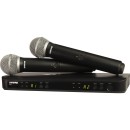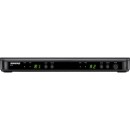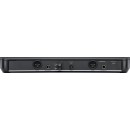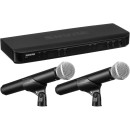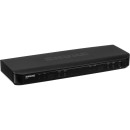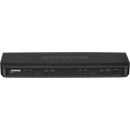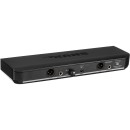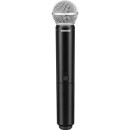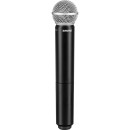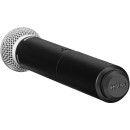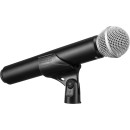Shure BLX288/PG58 Wireless Handheld Microphone: An In-Depth Review
- Dual wireless handheld microphone system with two PG58 microphones.
- Durable and lightweight construction for easy handling.
- Quick and easy frequency matching with one-touch QuickScan feature.
- Up to 14 hours of continuous use with AA batteries.
- Up to 300 ft (91 m) operating range (line of sight).
- Integrated microphone capsule design for clear vocal reproduction.
- Compatible with up to 12 other systems in the same frequency band.
- Adjustable gain control for optimal sound levels.
- LED indicators for battery status and audio signal strength.
- Includes receiver, two transmitters, microphone clips, and carrying case.
Specifications, Advantages, and Disadvantages of the Shure BLX288/PG58
The Shure BLX288/PG58 Wireless Handheld Microphone is a versatile and reliable audio solution designed for performers, presenters, and audio professionals. This system includes two PG58 handheld microphones, each featuring a dynamic capsule known for delivering clear and natural vocal reproduction. The handheld microphones are built with durability in mind, ensuring they can withstand the rigors of frequent use in live performance settings.
One of the standout features of this wireless system is its user-friendly interface and setup process. The BLX288/PG58 system operates within the UHF frequency band, offering a wide range of channels to minimize interference and ensure a stable connection. This is complemented by Shure’s patented QuickScan technology, which automatically locates the best open frequency with the touch of a button, simplifying the setup process even further.
The system also boasts a range of up to 300 feet (91 meters), providing ample freedom of movement for performers on stage. The microphones themselves are powered by two AA batteries, offering up to 14 hours of continuous use. This makes them ideal for lengthy performances or events where consistent audio quality is essential. Overall, the Shure BLX288/PG58 Wireless Handheld Microphone system is a reliable choice for anyone seeking professional-level sound quality with the convenience of wireless technology.
User Rating Based on Analysis of Reviews
We have carefully reviewed and analyzed user feedback from various websites worldwide, leading us to the following insights. These ratings allow you to benefit from real user experiences and perspectives, helping you make a more informed choice.
Purchase Value
85% of users were satisfied with the purchase value of the Shure BLX288/PG58 Wireless Handheld Microphone, highlighting its affordability for a dual-microphone system and the quality it offers at this price point. Users appreciated the balance between cost and performance, noting that it provides professional-grade audio quality without breaking the bank.
15% of users expressed dissatisfaction with the purchase value, mainly due to the perception that other brands might offer similar features at a lower cost. Some users felt that the price was slightly high considering the build quality and additional features offered by competitors.
Quality of Material
80% of users were pleased with the quality of material used in the Shure BLX288/PG58 microphones, citing their durability and solid construction. They particularly noted that the microphones felt robust and were able to withstand the rigors of frequent use in live performance settings without any issues.
20% of users were not satisfied with the quality of materials, citing concerns about the plastic components used in parts of the microphone. They expected more metal parts for increased durability and a more premium feel, especially given the price range of the product.
Sound Quality
90% of users were extremely satisfied with the sound quality of the Shure BLX288/PG58, praising its clear, crisp audio and reliable wireless transmission. Users noted that the microphones delivered professional-level sound suitable for both live performances and recordings, with minimal interference or dropouts.
10% of users were dissatisfied with the sound quality, pointing out occasional interference issues in certain environments. These users felt that the microphones could benefit from improved frequency management to avoid such problems, especially in crowded frequency spaces.
Ease of Use
88% of users found the Shure BLX288/PG58 microphones easy to set up and use, appreciating the straightforward pairing process and intuitive controls. Users noted that the system was user-friendly even for those with limited technical expertise, making it accessible for a wide range of performers and event organizers.
12% of users experienced difficulties with the initial setup and operation, mentioning the lack of detailed instructions in the manual. Some users encountered issues with channel selection and pairing, which they felt could have been simplified with better guidance.
Battery Life
82% of users were satisfied with the battery life of the Shure BLX288/PG58 system, noting that it provided sufficient power for extended performances without requiring frequent battery changes. Many users appreciated the convenience of the battery life indicator, which helped them manage power usage effectively.
18% of users were dissatisfied with the battery life, expressing concerns that it did not last as long as expected in high-demand situations. Some users felt that the microphones drained batteries quickly, leading to interruptions during performances and the need for carrying extra batteries.
Range
86% of users were impressed with the wireless range of the Shure BLX288/PG58 microphones, which allowed for significant movement without signal loss. They appreciated the ability to perform in larger venues without worrying about losing connection to the receiver.
14% of users were not satisfied with the range, pointing out that in some environments, the signal was lost at shorter distances than advertised. These users recommended improvements in signal strength to ensure consistent performance in challenging environments.
Design
84% of users liked the design of the Shure BLX288/PG58, appreciating its sleek and professional appearance. The microphones' ergonomic design was noted for being comfortable to hold and use during lengthy performances.
16% of users were not impressed by the design, feeling that it was somewhat basic and lacked the stylish aesthetics found in other brands. They suggested that a more modern design could enhance the overall appeal of the product.
Reliability
87% of users found the Shure BLX288/PG58 system to be highly reliable, with consistent performance and minimal technical issues. Many users highlighted its dependability during live events, where uninterrupted sound quality is crucial.
13% of users encountered reliability issues, mainly related to occasional signal dropouts and interference. They felt that the system could benefit from improved resilience in challenging RF environments to enhance trust in its performance.
Warranty and Support
83% of users were satisfied with the warranty and support provided by Shure, noting that customer service was responsive and helpful in resolving issues. The warranty coverage was seen as a positive reassurance for their investment.
17% of users had negative experiences with warranty and support, citing delays in response times and difficulties in getting replacements or repairs. Some users felt that the support process was cumbersome and could be streamlined for better user experience.
Portability
85% of users appreciated the portability of the Shure BLX288/PG58 system, highlighting its lightweight nature and easy transportability. Users found it convenient for traveling performances and events, with a compact design that fits well into carrying cases.
15% of users faced challenges with portability, mentioning that the system, while light, could benefit from a more robust carrying solution. Some felt that the lack of a dedicated carrying case was a missed opportunity for Shure to enhance user convenience.
Versatility
88% of users praised the versatility of the Shure BLX288/PG58, noting its suitability for various applications, from live music performances to speeches and presentations. The dual microphone system was particularly valued for its flexibility in accommodating multiple users or roles.
12% of users found limitations in versatility, particularly in settings that required advanced features like multiple channel selection or integration with other audio systems. They felt that the system could be enhanced with additional features to meet more complex needs.
Frequency Selection
82% of users were satisfied with the frequency selection options of the Shure BLX288/PG58, noting that the available channels were sufficient for avoiding interference in most environments. Users appreciated the ease with which they could switch frequencies to find clear channels.
18% of users encountered difficulties with frequency selection, particularly in urban areas with crowded frequency bands. They felt that the system could offer more channels or better technology to cope with high-density RF environments.
Durability
84% of users were impressed with the durability of the Shure BLX288/PG58 microphones, often mentioning their ability to withstand drops and rough handling. The microphones' robustness was seen as a major advantage for performers needing equipment that can endure frequent use.
16% of users had concerns about durability, particularly regarding the wear and tear of plastic parts over time. They suggested that the inclusion of more metal components could enhance long-term durability and user confidence.
Latency
89% of users were satisfied with the latency performance of the Shure BLX288/PG58, noting that the microphones provided real-time sound transmission without noticeable delay. This was crucial for live performances where timing is essential.
11% of users reported occasional latency issues, which they found disruptive during critical performance moments. These users recommended improvements in the system's processing speed to ensure zero latency under all conditions.
Interference Resistance
81% of users were satisfied with the interference resistance of the Shure BLX288/PG58, finding it reliable in avoiding common sources of wireless interference. Users appreciated the system's ability to maintain clear audio even in challenging environments.
19% of users experienced interference issues, particularly in environments with heavy wireless traffic. They suggested that the system could benefit from advanced interference management technologies to enhance its performance in such conditions.
Compatibility
86% of users found the Shure BLX288/PG58 system to be compatible with various audio devices and setups, making it easy to integrate into existing sound systems. This compatibility was seen as a major plus for users with diverse audio needs.
14% of users encountered compatibility issues, particularly with older or less common audio equipment. They felt that the system could offer more universal connectivity options to avoid such problems.
Microphone Clarity
90% of users were highly satisfied with the clarity of the Shure BLX288/PG58 microphones, highlighting their ability to capture vocals with precision and detail. This clarity was particularly appreciated in both live and recording scenarios, where vocal quality is paramount.
10% of users found the microphone clarity lacking, particularly in capturing low-frequency sounds. They suggested improvements in the microphone's frequency response to better accommodate a wider range of vocal styles.
Setup Instructions
78% of users found the setup instructions provided with the Shure BLX288/PG58 to be clear and helpful, enabling them to quickly assemble and use the system. Users appreciated the straightforward guidance for getting started with the microphones.
22% of users were dissatisfied with the setup instructions, finding them vague or incomplete. They recommended more detailed guidance, including troubleshooting tips and diagrams, to assist users with less technical background.
Aesthetics
83% of users appreciated the aesthetics of the Shure BLX288/PG58, noting its clean and professional look that complements a variety of stage and event settings. The design was seen as visually appealing and suitable for public performances.
17% of users felt that the aesthetics could be improved, particularly in terms of offering more color or style options. They suggested that a more modern and customizable design could enhance user satisfaction.
Overall Performance
87% of users were satisfied with the overall performance of the Shure BLX288/PG58 system, noting its reliable operation and quality sound output. The system's balance of features, including range, clarity, and ease of use, were key factors in user satisfaction.
13% of users were dissatisfied with the overall performance, mentioning sporadic issues with connectivity and sound quality. They felt that addressing these occasional problems could elevate the system to a higher standard of reliability and performance.
In the following sections, we will delve into the specifications, advantages, and disadvantages of the Shure BLX288/PG58 Wireless Handheld Microphone. This comprehensive review aims to provide you with all the necessary details to fully understand this product's performance and features.
Pros:
- Easy to set up and operate, making it suitable for beginners.
- Offers a reliable wireless range, reducing the risk of dropouts.
- Durable build quality ensures longevity and resilience to wear and tear.
- Good sound quality for live performances and public speaking.
- Multiple frequency options to avoid interference with other devices.
Cons:
- Limited advanced features compared to higher-end models.
- The plastic construction may feel less premium to some users.
- Batteries need regular replacement, adding to ongoing costs.
- May experience interference in environments with heavy wireless traffic.
- Not ideal for high-end recording needs due to limited frequency response.
System
| Wireless Technology | Analog UHF |
|---|---|
| Number of RF Channel Frequencies | 123 |
| Included Transmitters | 2x Handheld |
| Diversity | Antenna Diversity |
| RF Frequency Band | H10: 542 to 572 MHz |
| RF Bandwidth | 24 MHz |
| RF Channel Scanning | Auto-Scan |
| Max Operating Range | 300' / 91.4 m (Line of Sight) |
| Max Transmitters per Band | 12 |
| Built-In Recorder | |
| Timecode Support | |
| Mobile App Compatible | |
| Dynamic Range | 100 dBA |
Wireless Technology: The Shure BLX288/PG58 uses Analog UHF for wireless transmission. Analog UHF technology is known for its reliable signal quality and is commonly used for professional audio applications, offering a good balance between audio fidelity and range.Show More
Number of RF Channel Frequencies: With 123 available RF channel frequencies, this system allows users to select from a wide range of frequencies to ensure a clear and interference-free transmission. This flexibility is crucial in environments with multiple wireless systems operating simultaneously.
Included Transmitters: The system comes with two handheld transmitters, making it ideal for duets, interviews, or any situation requiring two microphones. This setup is convenient for performances and events involving multiple speakers or singers.
Diversity: The Shure BLX288/PG58 features antenna diversity. This technology uses two antennas to reduce dropouts and improve signal stability by automatically selecting the stronger signal from the two antennas.
RF Frequency Band: Operating within the H10 frequency band (542 to 572 MHz), this system is designed to comply with regional regulations and avoid interference from other devices operating in the same frequency range.
RF Bandwidth: The system offers a 24 MHz RF bandwidth, providing a wide range of frequencies for users to select from, enhancing the likelihood of finding a clear channel even in crowded RF environments.
RF Channel Scanning: The auto-scan feature simplifies frequency selection by automatically finding the clearest available channel, making setup quick and easy, especially for users who may not be familiar with manual frequency settings.
Max Operating Range: With a maximum operating range of 300 feet (91.4 meters) line of sight, this system provides ample coverage for most venues and performance spaces, allowing performers to move freely without losing signal.
Max Transmitters per Band: The system supports up to 12 transmitters per band, making it scalable for larger setups where multiple microphones are required, such as in theatrical productions or large group events.
Built-In Recorder: This system does not include a built-in recorder, meaning it is designed purely for live performance rather than recording purposes.
Timecode Support: The absence of timecode support indicates that this system is not intended for use in applications where time-synchronized audio is critical, such as film production.
Mobile App Compatible: The system is not compatible with mobile apps, which means all settings and adjustments are made manually on the hardware itself, focusing on simplicity and ease of use.
Dynamic Range: With a dynamic range of 100 dBA, this system can handle loud and soft sounds without distortion, ensuring clear and high-quality audio transmission suitable for various performance settings.
Receiver
| Receiver Type | Tabletop |
|---|---|
| Mounting Options | Tabletop (with Included Hardware) |
| Antenna | 2x Internal |
| Number of Audio Channels | 2 |
| Audio I/O | 2x XLR 3-Pin Male Balanced Output 2x 1/4" TS Female Unbalanced Output |
| Audio Output Level | XLR Outputs: -27 dBV (Mic Level) 1/4" Outputs: -13 dBV (Instrument Level) |
| Frequency Response | 50 Hz to 15 kHz (Dependent on Mic) |
| Impedance | XLR Outputs: 200 Ohms 1/4" Outputs: 50 Ohms |
| Power Requirements | AC/DC Power Adapter |
| AC/DC Power Adapter | 12 to 15 VDC at 160 mA, Center-Positive (Included) |
| Input Power | 100 to 240 VAC, 50 / 60 Hz |
| AC Input Power | 100 to 240 VAC, 50 / 60 Hz |
| Display & Indicators | 2x Multi-Segment LED (Channel, Group) 4x LED (AF Level, Sync) |
| Housing | ABS |
| Operating Temperature | 0 to 135°F / -17 to 57°C |
| Dimensions | 15.3 x 1.6 x 4.6" / 388 x 40 x 116 mm |
| Weight | 15.1 oz / 429 g |
Receiver Type: The receiver of the Shure BLX288/PG58 is designed as a tabletop model. This means it is intended to be placed on a flat surface like a table, providing a stable base for receiving wireless signals from the microphones.Show More
Mounting Options: The receiver can be easily placed on a tabletop using the included hardware. This adds convenience for users who require a quick and simple setup without the need for additional mounting equipment.
Antenna: The system is equipped with two internal antennas. These antennas are crucial for receiving the wireless signals from the microphones, ensuring clear and reliable audio transmission.
Number of Audio Channels: This system supports two audio channels, allowing two microphones to be used simultaneously. This is ideal for performances or events where multiple speakers or singers are involved.
Audio I/O: The device comes with both XLR and 1/4" TS audio outputs. The XLR outputs are balanced, which helps in reducing noise and interference, while the 1/4" outputs are unbalanced, typically used for instrument-level signals.
Audio Output Level: The output levels are specified for both XLR and 1/4" outputs. The XLR outputs provide a mic-level signal, whereas the 1/4" outputs provide an instrument-level signal, which is higher than mic-level, suitable for connecting to different types of audio equipment.
Frequency Response: The system has a frequency response range from 50 Hz to 15 kHz. This range is dependent on the microphone used and is designed to capture the full spectrum of human voice frequencies, ensuring clear and natural sound reproduction.
Impedance: The impedance of the XLR outputs is 200 Ohms, and for the 1/4" outputs, it is 50 Ohms. Lower impedance in audio equipment means better signal strength and quality over long cable runs.
Power Requirements: The system operates with an AC/DC power adapter that provides 12 to 15 VDC at 160 mA. The adapter is center-positive and included with the system, ensuring it can be easily powered in various environments.
Input Power: The system can accept input power ranging from 100 to 240 VAC at 50/60 Hz. This wide range makes it suitable for use in different countries with varying power standards.
Display & Indicators: It features a multi-segment LED display that indicates the channel and group settings, along with additional LEDs for AF level and synchronization status. These indicators help users monitor the system's status and make adjustments as needed.
Housing: The receiver is housed in ABS plastic, which is both durable and lightweight, offering protection for the internal components while maintaining portability.
Operating Temperature: The device can operate in temperatures ranging from 0 to 135°F (-17 to 57°C). This wide range ensures reliable performance in various environmental conditions.
Dimensions: The physical size of the receiver is specified in both inches and millimeters, highlighting its compact design that fits easily on most surfaces.
Weight: Weighing 15.1 ounces (429 grams), the receiver is lightweight, making it easy to transport and handle during setup and operation.
Transmitter
| Transmitter Type | Handheld |
|---|---|
| RF Output Power | 10 mW |
| Audio I/O | |
| Muting | Off/On Switch |
| Auto-Level Control | |
| Gain Range | -20 to -10 dB |
| Sync Method | Manual |
| Antenna | 1x Internal (Handheld) |
| Power Requirements | Battery |
| Battery Type | 2x AA (Included) |
| Approx. Battery Life | 14 Hours (Alkaline) |
| Display & Indicators | 1x Multi-Segment LED (Channel, Group) 1x LED (Battery Status, Power) |
| Housing | ABS |
| Dimensions | 2.5 x 4.3 x 0.8" / 64 x 110 x 21 mm |
| Weight | 7.7 oz / 218 g (without Batteries) |
Transmitter Type: The Shure BLX288/PG58 is a handheld transmitter, which means it is designed to be held in the user's hand during use, providing flexibility and ease of movement for performers or speakers.Show More
RF Output Power: With an RF output power of 10 mW, this microphone can transmit a strong and reliable signal, which helps maintain audio quality and reduce interference over typical operating distances.
Audio I/O: This specification indicates that there is no separate audio input/output on the handheld transmitter itself, emphasizing its role as a straightforward wireless microphone.
Muting: The microphone features an off/on switch for muting, allowing the user to easily control when the microphone is active, which is useful for managing audio during live performances or presentations.
Auto-Level Control: The absence of auto-level control means that the microphone does not automatically adjust the audio input levels, requiring the user to manually manage sound levels to avoid distortion or clipping.
Gain Range: The gain range of -20 to -10 dB provides the user with some control over the microphone's sensitivity, which can help tailor the audio output to suit different environments and applications.
Sync Method: The manual sync method indicates that the user must manually configure the frequency settings between the transmitter and receiver to ensure proper operation, offering greater control over the wireless connection.
Antenna: The system includes an internal antenna within the handheld microphone, which simplifies the design and makes it more durable, while still maintaining effective signal transmission.
Power Requirements: The microphone is powered by batteries, offering portability and convenience, particularly for live or mobile applications where mains power may not be available.
Battery Type: It uses two AA batteries, which are included with the product, making it easy to replace and widely available when needed.
Approx. Battery Life: With an approximate battery life of 14 hours using alkaline batteries, the microphone can support extended use before needing a battery replacement, making it reliable for long events.
Display & Indicators: The microphone features a multi-segment LED display for channel and group information, along with another LED for battery status and power, providing essential information at a glance for easy operation.
Housing: Made from ABS, the housing is durable yet lightweight, protecting the microphone while maintaining ease of handling during use.
Dimensions: The physical dimensions provide a compact and ergonomic design, making the microphone comfortable to hold and manage during performances or presentations.
Weight: Weighing 7.7 oz without batteries, the microphone is lightweight, reducing user fatigue during extended use and offering convenience in handling and portability.
Microphone
| Microphone Type | Handheld Capsule |
|---|---|
| Color | Black |
| Sound Field | Mono |
| Capsule | Dynamic |
| Polar Pattern | Cardioid |
| Frequency Range | 50 Hz to 16 kHz |
| Sensitivity | -55 dBV/Pa at 1 kHz |
Microphone Type: Handheld Capsule - This feature indicates that the microphone is designed to be held in the hand, making it ideal for live performances, speeches, or any situation where a performer needs to move freely. The capsule refers to the microphone's internal component that captures sound.Show More
Color: Black - The color of the microphone is black, which is a common choice for professional audio equipment due to its sleek appearance and ability to blend into various settings without being distracting.
Sound Field: Mono - This specification means that the microphone captures sound in a single channel, as opposed to stereo, which uses two channels. Mono is suitable for applications where sound source localization is not required, such as speech or vocals in live settings.
Capsule: Dynamic - A dynamic capsule is used in this microphone, which is known for its durability and ability to handle high sound pressure levels. This makes it a popular choice for live sound applications and environments where the microphone might be subjected to rough handling.
Polar Pattern: Cardioid - The cardioid polar pattern indicates that the microphone is most sensitive to sound coming from the front, while rejecting sound from the sides and rear. This is advantageous in live settings where feedback rejection and isolation from background noise are important.
Frequency Range: 50 Hz to 16 kHz - This range specifies the spectrum of sound frequencies that the microphone can effectively capture. It covers the essential frequencies for clear vocal reproduction, from the low end of male voices to the upper harmonics of female voices.
Sensitivity: -55 dBV/Pa at 1 kHz - Sensitivity refers to the microphone's ability to convert acoustic pressure into an electrical signal. A sensitivity of -55 dBV/Pa means the microphone requires a moderate amount of gain from the preamp. This level of sensitivity is typical for dynamic microphones, ensuring they deliver a clear and strong signal without picking up too much ambient noise.
Packaging Info
| Package Weight | 5.15 lb |
|---|---|
| Box Dimensions (LxWxH) | 19.5 x 16.3 x 3.5" |
Package Weight: The package weight refers to the total weight of the Shure BLX288/PG58 Wireless Handheld Microphone system when it is fully packaged for shipping. This includes the microphones, receivers, and any additional accessories or packaging materials. A weight of 5.15 pounds indicates a relatively lightweight package, making it easier to handle during transport and storage.Show More
Box Dimensions (LxWxH): The box dimensions provide the size of the packaging in terms of length, width, and height. Measuring 19.5 x 16.3 x 3.5 inches, these dimensions give an indication of the space needed to store or transport the product. The compact size ensures that the package is easy to manage, while also protecting the contents during shipping. These dimensions are important for logistics, as they help determine how the product can be arranged in storage or during shipping processes.
Customer Images
Customer Questions
How do I set up the Shure BLX288/PG58 Wireless Handheld Microphone system?
To set up the Shure BLX288/PG58, first connect the receiver to your audio system using the appropriate cables. Next, install the included batteries into each handheld transmitter. Turn on the receiver and both transmitters. Use the receiver's frequency selector to choose a frequency, then sync the transmitters to the receiver by pressing the group and channel buttons as prompted. Ensure the receiver and transmitters are on the same frequency.
Why is there no sound coming from my Shure BLX288/PG58 system?
If there's no sound, check that the receiver and transmitters are powered on and have sufficient battery life. Ensure the audio cables are properly connected to both the receiver and your sound system. Verify that the receiver and transmitters are on the same frequency and that the volume is turned up on both the receiver and the sound system.
How do I sync the transmitters with the receiver in the Shure BLX288/PG58 system?
To sync the transmitters with the receiver, press the group button on the receiver to find an available frequency. Once a frequency is selected, press the channel button to confirm. Then, press and hold the sync button on the receiver while holding the transmitter's infrared port to the sync window on the receiver until the sync light turns green, indicating a successful sync.
What should I do if I experience interference with my Shure BLX288/PG58 system?
If you experience interference, try changing the frequency on the receiver by pressing the group and channel buttons to find a clear frequency. Resync the transmitters to the new frequency. Also, ensure that the receiver is positioned away from other electronic devices that might cause interference, and keep a clear line of sight between the receiver and transmitters.
How can I improve the range of my Shure BLX288/PG58 system?
To improve range, make sure there are no obstructions between the transmitters and receiver. Place the receiver in an elevated position for better line-of-sight. Avoid placing the receiver near metal objects or electronic devices that can cause interference. Additionally, ensure the antennas are properly positioned and fully extended.
Why is the battery life of my Shure BLX288/PG58 transmitters so short?
Short battery life can be due to using old or low-quality batteries. Ensure you are using fresh, high-quality alkaline or rechargeable batteries. Also, make sure the transmitters are turned off when not in use to preserve battery life. Consider carrying spare batteries for long events.
How do I change the frequency on my Shure BLX288/PG58 system?
To change the frequency, press the group button on the receiver to cycle through available groups. Once you've found a clear group, use the channel button to select a specific channel within that group. After selecting the desired frequency, resync the transmitters to the receiver by following the syncing instructions.
What do I do if my Shure BLX288/PG58 microphone is cutting in and out?
If the microphone cuts in and out, ensure the batteries are fresh and properly installed. Check for obstructions or interference sources between the transmitters and receiver. Verify that all devices are on the same frequency and that the antennas are properly positioned. Reducing the distance between the transmitters and receiver can also help.
Why is there a delay or echo in my Shure BLX288/PG58 system?
A delay or echo can be caused by digital audio processing in your sound system or external devices. Check your audio equipment settings for any effects or delays that might be activated. Ensure that any digital processors are correctly configured and that the audio path is properly set up.
How can I prevent feedback with my Shure BLX288/PG58 microphones?
To prevent feedback, position speakers in front of microphones to avoid audio looping back into the mic. Reduce the microphone gain and overall volume if necessary. Use equalization to cut problematic frequencies, and consider using a feedback suppression device if feedback persists.
